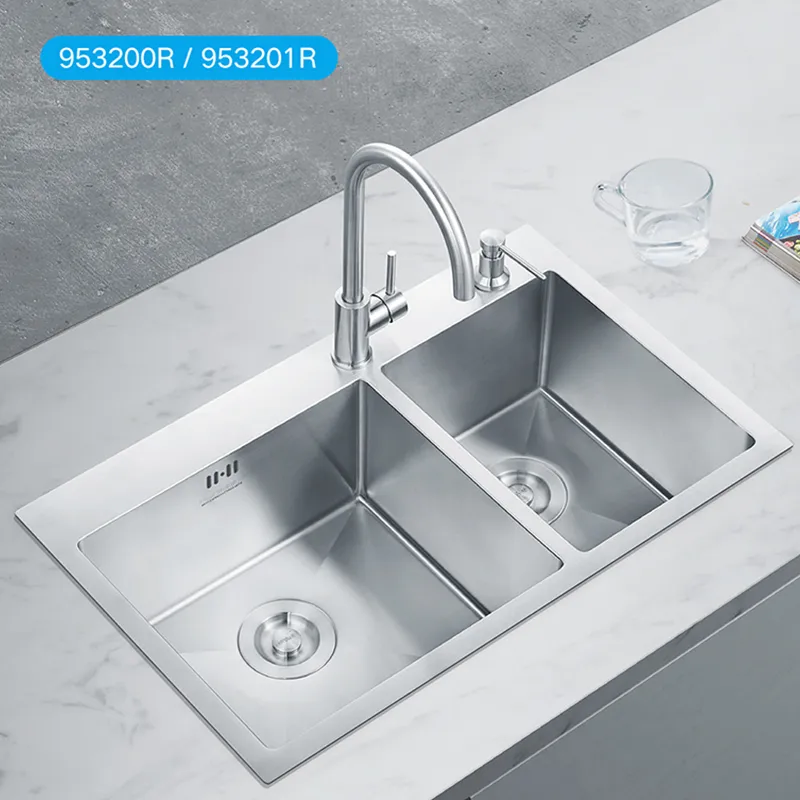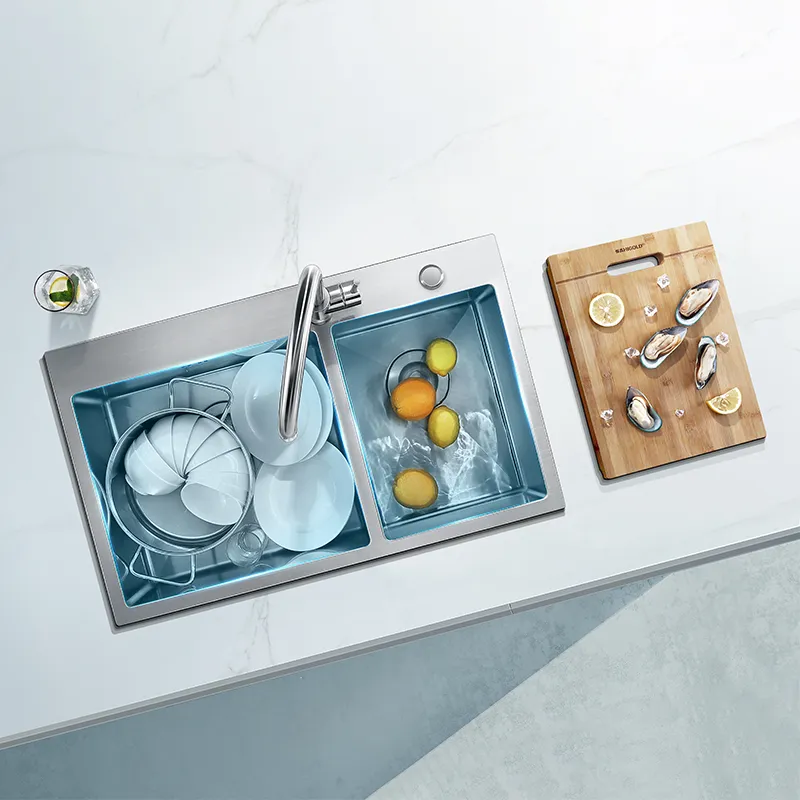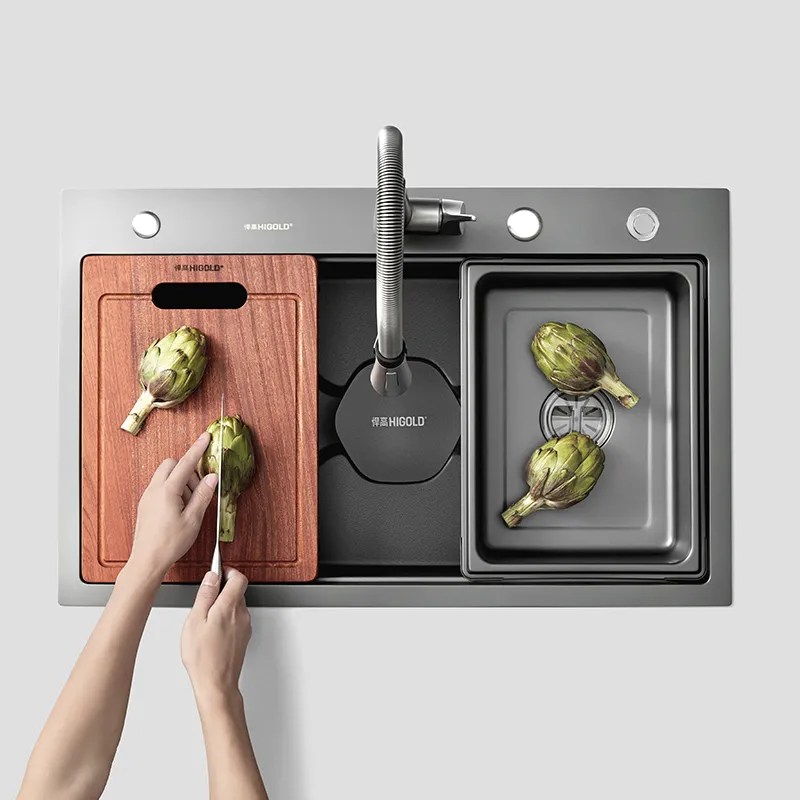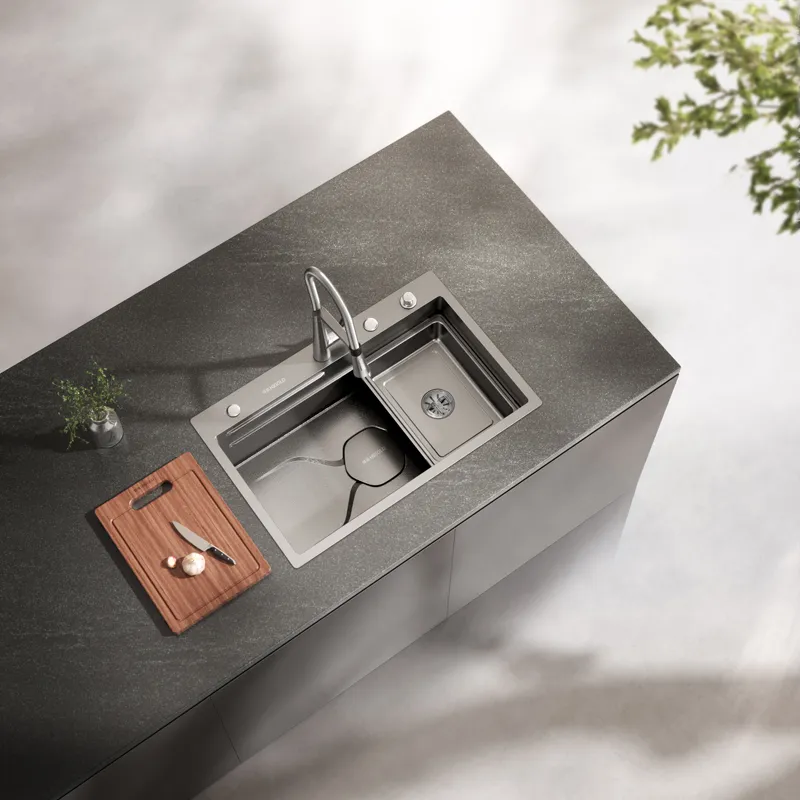Stainless steel kitchen sinks are a top choice for many homes and commercial spaces due to their strong corrosion resistance, ease of cleaning, modern appearance, and durability. However, scratches, fine lines, and water stains are inevitable during daily use.
Many users have the same question after seeing these marks:
"Are scratches on stainless steel kitchen sinks permanent?"
This question seems simple, but it actually involves many factors, including the structure of the stainless steel material, surface treatment, usage, type of scratch, and cleaning and repair methods.
This article will provide an in-depth analysis from a professional perspective on whether scratches on stainless steel kitchen sinks are permanent, why they occur, whether they can be repaired, and which scratches can be restored, giving you a complete understanding of the essence behind "scratches on stainless steel kitchen sinks."

Are scratches on stainless steel sinks always permanent?
Many people believe that once a stainless steel surface is scratched, it's "ruined," but this is not the case.
Whether scratches on a stainless steel kitchen sink are permanent depends on the depth, direction, and surface treatment of the scratch.
1. Minor scratches are not permanent
Most of the fine scratches seen on stainless steel kitchen sinks are actually minor surface wear. These scratches are typically:
• Very shallow
• Irregularly distributed
• More noticeable when the angle of light changes
• Can be faded or even disappeared with appropriate methods.
These minor scratches are mostly "recoverable" and can be restored to near-new condition with simple wiping, metal polishing, or reverting to a brushed finish.
2. Moderate scratches can usually be significantly improved
While moderate scratches are more noticeable than minor scratches, they are still repairable. If the stainless steel itself is thick enough, they can be repaired by polishing along the brushed direction.
3. Deep scratches may be permanent
When there are obvious dents or scratches that penetrate deep into the metal, causing "material damage," these scratches are usually difficult to completely restore and can only be addressed by improving the appearance or partially concealing them.
In summary:
Scratches on stainless steel kitchen sinks are not necessarily permanent; most are recoverable or can be significantly reduced in appearance.

Why are stainless steel sinks prone to scratches? Is it a material issue?
Many users believe that "stainless steel scratches easily = poor material," but this is a common misconception. The reasons for scratches on stainless steel sinks are related to the material structure, daily usage habits, and surface texture.
1. Stainless steel surfaces naturally have fine lines
Most stainless steel kitchen sinks use a brushed finish. The so-called "brushed texture" itself is composed of many tiny lines; therefore, minor scratches are often just visual changes caused by inconsistent brushing direction.
2. The inherent properties of metal materials make them susceptible to scratches from hard objects
The hardness of everyday tools such as pot bottoms, knives, metal bowls and plates, tableware, and strainers may be the same as or slightly higher than stainless steel, making them easily scratched by friction.
3. Inevitable friction during use
Any surface will wear down over time due to prolonged contact with objects.
Stainless steel kitchen sinks, in particular, are subjected to:
• Washing pots and pans
• Rinsing before food preparation
• Rinsing tableware
• The scouring action of grit in water during rinsing.
These high-frequency scenarios naturally lead to fine lines on the surface.
4. The visual effect of scratches is magnified by lighting angles
Stainless steel has a certain degree of reflectivity. Under light or sunlight, the lines in different directions create a stronger visual contrast, making scratches appear more noticeable than they actually are.
Therefore:
Scratches on stainless steel kitchen sinks are not a quality issue, but a normal phenomenon caused by the material's characteristics combined with usage.

Does the surface treatment of stainless steel sinks affect the permanence of scratches?
The surface treatment of stainless steel kitchen sinks significantly impacts scratch formation and repair. The key to scratch removal is the surface finish.
1. Brushed: Least prone to scratches
Brushed stainless steel has a directional texture, so minor scratches usually blend into the existing texture and are not noticeable.
Minor scratches are also easily repaired by readjusting the brushing direction.
2. Satin: Hides most fine lines
Satin is finer than brushed, with lower reflectivity, making scratches less visible.
Minor scratches are easily blurred by a sanded finish.
3. Mirror-finish: Most prone to scratches, but mostly used for decoration
While mirror finishes are aesthetically pleasing, scratches are almost always noticeable once they appear.
However, mirror finishes are generally not used for stainless steel kitchen sinks because they are impractical.
From a manufacturing perspective, most stainless steel kitchen sinks use a brushed finish, so scratches on them are mostly repairable.
Can minor scratches on a stainless steel sink disappear on their own?
Many people find that:
A newly purchased stainless steel kitchen sink actually looks better after a period of use than when it was first installed.
This is because:
1. Stainless steel surfaces develop a natural, even matte texture
Prolonged contact with dishes, pots, pans, and fabrics gradually covers initially uneven scratches with a more even texture.
2. Regular washing makes the surface more even
Slight friction from sponges, scouring pads (not steel wool), and dishcloths helps old scratches blend naturally.
3. Minor scratches will integrate into the existing brushed texture
As long as the direction is consistent, minor scratches will be visually hidden.
Therefore:
Many fine lines on stainless steel kitchen sinks will naturally fade over time, which is normal.

What types of scratches can be repaired or faded?
Not all scratches are the same, and different scratches have different effects on stainless steel sinks.
1. Repairable or Reducible Scratches
• Minor fine lines caused by sponge friction
• Small scratches caused by tableware sliding
• Shallow scratches caused by light contact with hard objects
• Scratches with a direction similar to the brushed finish
These are superficial scratches and can be reduced or nearly eliminated through cleaning, brushing, or metal polishing.
2. Scratches More Difficult to Completely Repair
• Deep dents that can be clearly "stuck" by a fingernail
• Deep lines scratched by a sharp metal tip
• Very obvious reverse scratches, with a direction completely different from the brushed finish
• Slight deformation on the stainless steel surface
These scratches can improve the appearance but are often difficult to completely restore.
Therefore:
Whether a scratch can be repaired depends on its depth, direction, and surface finish.
Will scratches on a stainless steel sink affect its rust resistance?
Many people worry that scratches will make stainless steel kitchen sinks more prone to rust.
The answer is:
1. Scratches do not affect the rust-resistant mechanism of stainless steel
Stainless steel's rust resistance comes from its chromium-rich metallic nature, not from a surface coating.
Even with scratches, this protective mechanism remains.
2. Stainless steel automatically forms a new protective film
Even with minor surface damage, it quickly forms a new protective oxide layer in the air through a "passivation reaction."
3. Scratches only have an impact if they are very deep and expose lower-grade steel
However, standard stainless steel kitchen sinks are usually made of 304 or 316 stainless steel, so this is unlikely to happen easily.
Therefore:
Scratches do not affect the rust resistance of stainless steel kitchen sinks.
Is it normal for stainless steel sinks to have scratches?
The answer is yes.
1. Stainless steel kitchen sinks are frequently used items
Used dozens of times a day, slight surface wear is an unavoidable and normal phenomenon.
2. The inherent characteristic of stainless steel is that it is "durable but will wear down."
Wear-resistant ≠ scratch-free
Unbreakable ≠ unmarkable by metal tools
3. There is no such thing as a "completely scratch-free" metal surface
Any metal will develop fine scratches through friction.
Therefore:
Scratches on stainless steel kitchen sinks are normal, common, and nothing to worry about excessively.
How to make the surface of a stainless steel sink look more wear-resistant and less prone to scratches?
While this article doesn't involve actual examples, it explains some general practices from the perspective of material structure principles and common knowledge.
1. Use a cleaning method consistent with the grain direction
Wiping with the grain direction avoids the reinforcing effect of scratches from the opposite direction.
2. Use a sink strainer, a basin within a basin, etc., to reduce metal-to-metal friction
Reduce direct friction between hard objects and the bottom of the sink.
3. Avoid using steel wool to scratch
Steel wool will leave deep, intersecting scratches that are difficult to repair.
4. Keep the surface clean
A mixture of oil and grit will worsen wear.
While scratches are unavoidable, they can help maintain a more even and aesthetically pleasing finish on your stainless steel sink.
Are scratches on stainless steel sinks permanent?
The answer is—mostly no.
1. Most scratches on stainless steel sinks are not permanent
• Minor scratches will fade naturally.
• Moderate scratches can be repaired to become less noticeable.
• Deep scratches are more difficult to fully restore, but are not common.
2. Scratches are normal and do not indicate poor sink quality or impaired rust resistance
The corrosion resistance of stainless steel is not affected by minor scratches.
3. The brushed finish of stainless steel sinks gives them excellent "scratch absorption" properties
The longer they are used, the more even the scratches become, making them even more aesthetically pleasing.
Therefore, if you are currently using or planning to buy a stainless steel sink, don't worry too much about scratches. They are not a serious functional defect, but rather a natural property of the material.
How experienced is Higold in exporting kitchen sinks?
Higold has more than 20 years of exporting experience, with a strong logistics and supply chain network serving over 86 countries. Our long-term cooperation with major brands proves our reliability as a global supplier. Buyers can request fast quotes, competitive wholesale prices, and ODM customization, all supported by a professional export team that ensures timely delivery and smooth purchasing.


